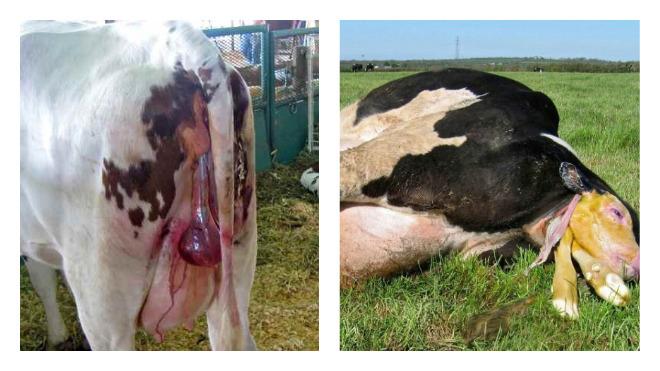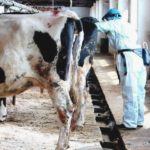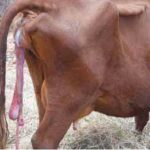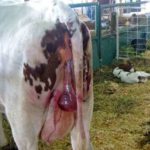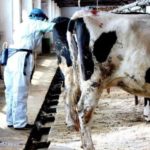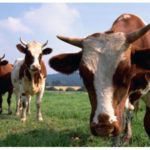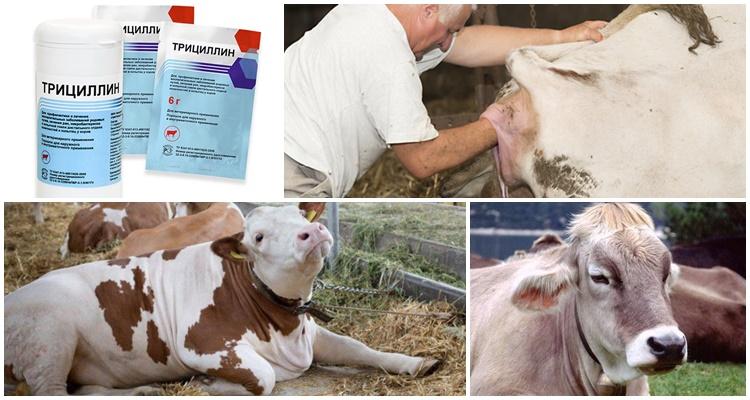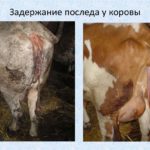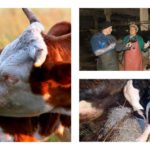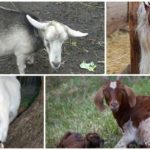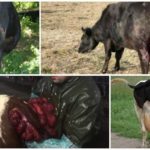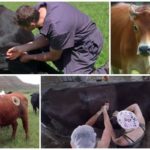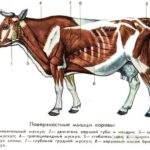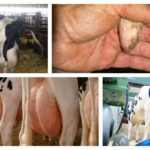In all living beings, the birth process ends with the rejection of the placenta. Unfortunately, the appearance of offspring does not always go smoothly. Retained placenta is a common complication after birth in cows and other animal species. The body of a horned pet is sensitive to the negative effects of the environment. The birth process can be affected by poor nutrition, lack of exercise and other factors.
What is afterbirth and what does it look like?
The afterbirth is a special organ (placenta) that provides protection and nutrition to the calf during intrauterine development. The formation of the organ occurs during pregnancy, simultaneously with the development of the embryo. The placenta is a sac dotted with small blood vessels. The organ consists of several membranes: urinary, aqueous and vascular. In most cases, the afterbirth is gray in color. Due to the large number of venous nodules, the surface of the organ looks lumpy.
2-6 hours after birth, the placenta should separate from the walls of the cow's uterus. The maximum waiting time for a child's seat to come out is 8 hours. If during this time the placenta does not come out, then we are talking about retained placenta. A similar problem occurs in many species of animals, but cows are the most susceptible to misfortune. This is due to the specificity of the structure of the placenta in cattle. There are 2 types of child seat compartments:
- Complete, if all the membranes have separated from the uterus and left the animal’s body.
- Incomplete, if the baby's place was separated only partially, and the remains of the placenta lingered in the cow's uterus.
Why are there delays?
The reasons for delayed child placement are divided into 2 categories: general (predisposing) and personal.
Common reasons include:
- Deficiency of vitamins and minerals in the pet’s body. A cow's monotonous diet and the dominance of canned feed lead to vitamin deficiency.
- High degree of obesity. During pregnancy, your pet needs additional nutrition, but a large amount of high-calorie food leads to rapid weight gain. Any metabolic disorder threatens to retain the placenta.
- Clearly underweight.
- Carrying more than 1 fetus. Too large a fruit can also be a problem.In both cases, the walls of the uterus are greatly deformed and stretched, as a result of which the organ contracts poorly.
- Insufficient physical activity. A reduction in the number of walks inevitably leads to a weakening of the tone of the pet’s uterus. In winter, cows are limited in their movements, so placenta retention occurs in many pets.
Personal reasons include:
- Fusion of the baby's place with the tissues of the uterus.
- Individual structural features of organs. These could be bends or other pathologies.
- Complete atony or partially weakened tension of the animal's uterus.
- Previous diseases (mastitis or endometritis). Even a cold that attacks a pet during pregnancy can lead to trouble.
- Congenital deformities of the fetus.
- Trauma to the birth canal during difficult, complicated childbirth.
Signs and symptoms
In cattle, there are 2 types of complications associated with separation of the placenta: complete and partial. With complete retention of the child's place in the vaginal area, fragments of the membranes are visible.
They usually have a grayish or red tint. In the complete absence of uterine tone, the placenta is completely hidden in the organ cavity.
Pathogenic microbes easily penetrate the birth canal. Pathogenic microflora rapidly develops in the uterus, and as a result, the pet’s body is subjected to severe intoxication.
- The animal is depressed and reacts sluggishly to external stimuli.
- Parts of the placenta hang from under the pet's tail. After 2 days, the shells begin to gradually decompose (in winter, the rotting process begins after 4 days). Decomposition occurs in the form of purulent-catarrhal endometritis. Mucus mixed with pus particles comes out of the cow's vagina.
- The child's seat emits an unpleasant odor and acquires a flabby consistency.
- Due to inflammatory processes, the cow's temperature rises sharply.
- The animal loses its appetite. In some cases, intestinal upset occurs.
- The pet produces little milk.
- The cow pushes, hunches her back and tightens her belly.
- The pet's fur is dull and tousled.
- The animal suffers from rapid heartbeat and low blood pressure.
- The cow makes moaning sounds.
How to Diagnose the Problem
Calving should occur under the supervision of the owner. This makes it easier to control the birth process. Animals often eat the afterbirth, and in this case it is not easy to determine whether the child’s place has been retained. There is no need to panic if your pet has eaten the placenta; the cow’s health is not in danger. If more than 8 hours have passed since calving and the placenta has not passed away, you need to seek help from a specialist. The veterinarian will examine the cow and conduct an examination of the internal cavity of the uterus. Farmers with many years of experience carry out diagnostics themselves. Putting on special gloves, the specialist carefully inserts his hand into the pet’s vagina and carefully feels the walls of the uterus.
In some cases, the afterbirth is laid out on a flat surface and examined carefully. The integrity of the child's seat is judged by the thickness of the membranes, the presence of ruptures and the condition of the blood vessels. If the veterinarian has any doubts, the afterbirth is subjected to bacteriological and microscopic analysis.
Treatment methods
The initial stage of treatment consists of auxiliary methods of solving the problem. The procedures are aimed at strengthening the muscles of the uterus and increasing the overall tone of the animal. The sick pet is given daily exercise. The procedure is carried out 2 times a day, in the morning and evening. The duration of the active walk is 30-40 minutes. If the hanging placenta interferes with the pet’s movements, the placenta is tied up. To do this, several nodes are made on the shells. In this case, the cow will not be able to touch the hanging placen with her feet and will be able to move freely.
Treating an animal with amniotic fluid is effective. 6-7 liters of healing liquid are collected during calving. The substance is diluted with clean warm water and given to the pet to drink. At one time, take 2 liters of amniotic fluid and 2 liters of clean water. In severe cases, the procedure is repeated 3 times, with an interval of 6 hours. The therapeutic effect of amniotic fluid occurs within 30 minutes after consumption.
To replenish lost strength and increase overall tone, the pet is given 500 g of honey or sugar. The treat is diluted in 1 liter of clean, hot water. If auxiliary measures do not bring results, you should immediately proceed to drug treatment, and in severe cases, to surgical intervention. Delayed actions lead to swelling of the caruncles in the uterine cavity and the rapid development of pathogenic microflora.
Operation
If drug treatment does not produce tangible results, surgery is necessary. The veterinarian injects the animal with an anesthetic and begins the procedure. Holding the hanging parts of the membranes with the fingers of his left hand, the veterinarian inserts his right hand into the pet’s vagina and removes the placenta.If the baby's place has fused with the wall of the uterus, the placenta is carefully separated with your fingers. Under no circumstances should the shells be separated by force. To facilitate the procedure, the veterinarian massages the walls of the organ. This helps to separate the afterbirth naturally.
Then the cavity is carefully palpated and the remaining particles of the membranes are removed. After the surgical intervention is completed, the organ is treated with antibacterial drugs (Tricillin, Exuter, Metromax). Also, the uterine cavity should be treated with a 10% salt solution, furatsilin or a solution of potassium permanganate.
Medicines
To strengthen the muscles of the uterus, use a 10% calcium chloride solution or a glucose solution (40%). 150-200 ml of product is enough for one individual. The medicine is administered to the pet intravenously. The treatment regimen is prescribed by a specialist. Some specialists use a 5% solution of hypertonic sodium chloride. 5 liters of warm solution is poured into the pet’s uterine cavity. As a result of the procedure, the membranes are compressed, and the uterus makes contractile movements.
Hormonal agents
Atony of the animal's uterus is susceptible to the influence of hormonal drugs. The following products will help restore the organ’s former muscles: “Sinestrol” (1% oily solution), “Pituitrin”, “Proserin” (0.5%), “Carbacholine” (0.01 aqueous solution), “Estrone”.
Antibiotics
Veterinarians usually use the drug Tricilin. The product contains streptomycin, penicillin, and white streptocide. The drug is made in the form of suppositories or powder. For one individual, 1 bottle of product or 3-4 candles is enough. A day later the procedure is repeated. The third dose of the medicine is given after 48 hours.
Possible danger
Delay in diagnosis and treatment can result in severe, and sometimes irreversible, consequences for animals.In a sick cow, metabolic processes are disrupted, serious damage to the endometrium occurs, and destructive pathogenic microflora develops in the uterus. This leads to general poisoning of the cow’s body and sepsis. An advanced disease ends in the death of the pet.
Preventive actions
Simple measures will help you avoid postpartum complications:
- Properly formulated diet. Animal food must contain the required amount of vital microelements and vitamins.
- Frequent walks. Physical activity promotes normal muscle development in your pet.
- Maintaining cleanliness in areas where cows are kept.

